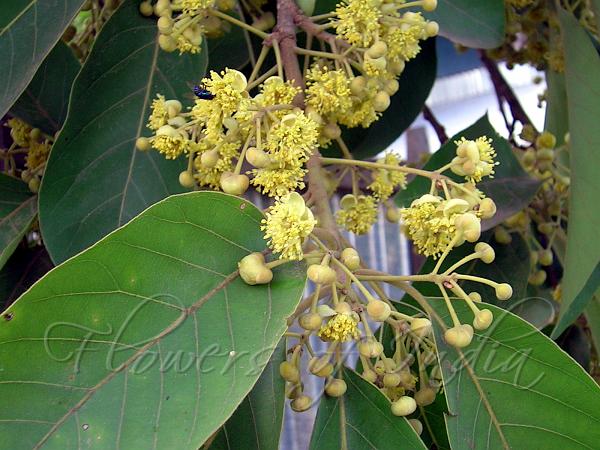|
| Soft Bollygum |
|

|

| File size | 426272 |
| Original date | 5/21/07 1:20 PM |
| Resolution | 1600 x 1200 |
| Flash | Flash did not fire, auto |
| Focal length | 8.0mm |
| Exposure time | 1/97s |
| Aperture | 3.2 |
| Focus Distance | |
| Metering Mode | Partial |
| Camera make | NIKON |
| Camera model | E3700 |
| Sensor type |
|
|
|
|
Photo: |
Botanical name: Litsea glutinosa Family: Lauraceae (Laurel family)
Synonyms: Litsea laurifolia, Sebifera glutinosa, Tetranthera laurifolia
Synonyms: Litsea laurifolia, Sebifera glutinosa, Tetranthera laurifolia
Indian Laurel is an evergreen or deciduous trees, 3-15 m tall. Young
branchlets are gray-yellow velvety. Alternately arranged leaves are
carried on 1-2.6 cm long gray-yellow velvety stalks. Leaves are mostly
elliptic but variable, 7-15 x 3-7 cm, velvety on both surfaces when young,
lateral veins 5-12 pairs. Leaf base is wedge-shaped blunt or rounded, tip
blunt or shortly tapering. Flowers are borne in solitary or several,
few-flowered umbels on short branchlets. Stalks carrying the umbels are
1-1.5 cm. Male flowers have petals imperfect or missing. Fertile stamens
are often 15 or more. Fruit is round, 5-7 mm in diameter, fruit-stalk is
3-6 mm, slightly thickened at the top. Flowering: May-June.
Medicinal uses: The root bark and leaves are used medicinally to reduce fever, reduce swelling, and treat diarrhoea.
They also may be used for treating furunculosis. The leaves, and the mucilage
in the gum from the bark, have been used for making poultices.
The bark acts as a demulcent and mild astringent in the treatment
of diarrhoea and dysentery. A decoction of the bark is used in the treatment of intestinal catarrh.
The root bark and leaves are used medicinally to reduce fever, reduce swelling, and treat diarrhoea.
They also may be used for treating furunculosis. The leaves, and the mucilage
in the gum from the bark, have been used for making poultices.
The bark acts as a demulcent and mild astringent in the treatment
of diarrhoea and dysentery. A decoction of the bark is used in the treatment of intestinal catarrh.
Medicinal uses:
 The root bark and leaves are used medicinally to reduce fever, reduce swelling, and treat diarrhoea.
They also may be used for treating furunculosis. The leaves, and the mucilage
in the gum from the bark, have been used for making poultices.
The bark acts as a demulcent and mild astringent in the treatment
of diarrhoea and dysentery. A decoction of the bark is used in the treatment of intestinal catarrh.
The root bark and leaves are used medicinally to reduce fever, reduce swelling, and treat diarrhoea.
They also may be used for treating furunculosis. The leaves, and the mucilage
in the gum from the bark, have been used for making poultices.
The bark acts as a demulcent and mild astringent in the treatment
of diarrhoea and dysentery. A decoction of the bark is used in the treatment of intestinal catarrh.
| Identification credit: J.M. Garg | Photographed in Imphal, Manipur. |
• Is this flower misidentified? If yes,